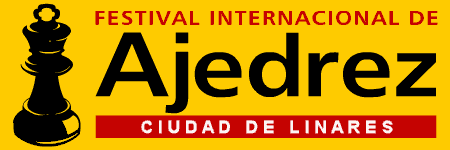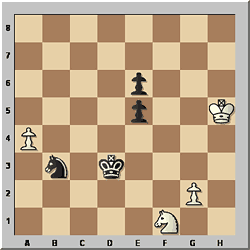

Round thirteen
Round 13: Friday, March 9th |
Vishy Anand |
½-½ |
Peter Leko |
Levon Aronian |
½-½ |
Vassily Ivanchuk |
Alex. Morozevich |
1-0 |
Veselin Topalov |
Magnus Carlsen |
½-½ |
Peter Svidler |
|
|
Round 14: Saturday, March 10th |
| Peter Leko |
- |
Magnus Carlsen |
Peter Svidler |
- |
Alex. Morozevich |
Veselin Topalov |
- |
Levon Aronian |
Vassily Ivanchuk |
- |
Vishy Anand |
Games – Report |
|
Standings after thirteen rounds

Commentary by GM Mihail Marin
The following express commentary was provided by Romanian GM Mihail Marin,
who is the author of a number of very popular ChessBase training CDs and articles
for ChessBase Magazine. GM Marin will study the games of the Morelia/Linares
tournament in greater detail and provide the full results of his analysis in
the next issue of ChessBase
Magazine.

Anand,V (2779) - Leko,P (2749) [C88]
XXIV SuperGM Linares, ESP (13), 09.03.2007 [Mihail Marin]
1.e4 e5 2.Nf3 Nc6 3.Bb5 a6 4.Ba4 Nf6 5.0-0 Be7 6.Re1 b5 7.Bb3 0-0 8.h3 Bb7
9.d3 Re8 10.Nc3 h6 11.Nd5 Na5 12.Nxe7+ Qxe7 13.Nh4 Nxb3 14.Nf5 Qe6 15.axb3
For the second time in a row, Anand treats the Anti-Marshall in a peaceful
way. 15...d5. Black is better developed and will have little trouble
extinguishing White's light initiative on the kingside. 16.Qf3 dxe4 17.dxe4
Kh7 18.Qg3 Rg8 19.f3 Ne8 20.Bd2 Nd6 21.Ne3. The exchange of knights would
have led to an obvious draw in view of the presence of opposite coloured bishops.
21...Bxe4. This trick has more of an aesthetic value, because White can
get the pawn back with his next move. 22.Bc3. Remarkably, White cannot
defend both his attacked pieces after 22.fxe4? Nxe4. 22...Bg6 23.Qxe5 Qxe5
24.Bxe5 Rgd8 25.g4 f6 26.Bg3 1/2-1/2. [Click
to replay]


Aronian,L (2744) - Ivanchuk,V (2750) [E17]
XXIV SuperGM Linares, ESP (13), 09.03.2007 [Mihail Marin]
1.d4 Nf6 2.c4 e6 3.Nf3 b6 4.g3 Bb7 5.Bg2 Be7 6.0-0 0-0
7.d5!? This move was introduced in top level games by Polugajevsky
during his Candidate's match against Kortschnoj, back in 1981. Polugajevsky
was probably exasperated by the fact that he could not get an advantage in the
"normal" line 7.Nc3 Ne4 8.Qc2 Nxc3 9.Qxc3 f5 (in fact, he even lost
one game with it in that match, as he had done 3 years earlier against the same
opponent and same kind of event.) Later, the young Kasparov included this interesting
pawn sacrifice into his repertoire. However, Black gradually discovered ways
to stand the first way of White's assault. 7...exd5 8.Nh4. This is Polugajevsky's
novelty. He came up with it in the last game of the match, when he desperately
needed to win in order to even the score. Previously, he tried the known 8.Nd4
in two games of the match. 8...c6 9.cxd5 Nxd5 10.Nf5 Nc7 11.Re1 d5 12.e4

2...d4!? A rare move and a pragmatic decision. Black returns the pawn
for the sake of rapid development. 13.Nxd4. 13.Qg4 g6 14.e5 Bc8?! 15.Nxe7+
Qxe7 16.Qxd4 led to an advantage for White in Mamedyarov-Palo, Chalkidiki 2001.
Black should probbaly prefer 14...Ne6, defending his extra-pawn. If one is going
to suffer, he should have some consolation at least. 13...c5 14.Nf5 Nc6 15.Nc3.
A novelty over 15.e5 when after 15...Qxd1 16.Rxd1 Rfd8 17.Bd2 Bf8 18.Nc3
Ne6 the control of the d4-square and the stability of the e6-knight offered
Black a reasonable position in Piket-Almasi, Monaco 2002. 15...Nd4. Now
that this knight is not pinned anymore, it can jump on this active square. 16.Bf4.
It might look tempting to capture on e7, but this would just eliminate White's
most active piece and help Black complete his development. 16...Bf6.
Black should also avoid releasing the tension. After 16...Nxf5 17.exf5 Bxg2
18.Kxg2 it would be hard to improve the position of the c7-knight and retain
some chances for the control of at least one of the central files. For instance,
18...Ne8 19.Qf3 with dangerous initiative for White. The main alternative to
the text move was 16...Nce6 , consolidating the d4-knight. 17.e5!?

An interesting exchange of tactical blows starts now. 17...Bxg2 18.exf6
Bf3 19.Ne7+ Kh8 20.Bxc7 Qxc7 21.Nb5 Bxd1 22.Nxc7 Bc2 23.Nxa8 Nf3+ 24.Kg2 Nxe1+
25.Rxe1 Rxa8 26.Nd5 gxf6 27.Nxf6 Kg7 28.Nh5+ Kf8 29.g4. The position has
calmed down and is about equal. 29...Rd8 30.Nf6 h6 31.Kg3 Kg7 32.Nh5+ Kf8
33.Nf6 Ba4 34.Ne4 Bc6 35.Nc3 Rd2 36.Re2 Rd4 37.Re1 Bd7 38.f3 Be6 39.a3 Rd2 1/2-1/2.
[Click to replay]

Carlsen,M (2690) - Svidler,P (2728) [E60]
XXIV SuperGM Linares, ESP (13), 09.03.2007 [Mihail Marin]
1.d4 Nf6 2.c4 g6 3.Nf3 Bg7 4.g3 c6 5.Bg2 d5 6.Qa4!? If White intends
to avoid the symmetrical position arising after the exchange on d5, he usually
defends his c-pawn with 6.b3 or 6.Qb3. However, the game move has also been
played and could simply transpose to 6.Qb3 if Black captures on c4. 6...0-0
7.0-0 Bf5. Black takes advantage of the lack of pressure against the b7-pawn
to take the important e4-square under control. The attempt to take advantage
of the queen's placement on a4 with 7...Nbd7 fails to equalize completely, for
instance 8.cxd5 Nb6 9.Qa3 cxd5 (Now, 9...Nfxd5 would be met by
10.e4 Nc7 11.Nc3 , consolidating White's advantage of space.) 10.Nc3
Nc4 11.Qb4 e6 12.Bf4 Re8 13.Ne5 Bf8 14.Qb3 Nd6 15.Bg5 Be7 16.Rfd1 Nf5

Analysis diagram
Black has moved arond with thisknight quite a lot. Little wonder that White's
development is superior, allowing him obtain a strong initiative with 17.e4 ,
Portisch-Ivkov, Petropolis Interzonal 1973.
8.Nc3 Nbd7 9.cxd5 Nb6 10.Qb3 Nfxd5
Black has not managed to put White's central pawn under pressure, but his development
is acceptable and the thematical advance e2-e4 quite difficult to carry out.
A typcal position for the Grünfeld. 11.Rd1 Qd6 12.Bd2 Nxc3 13.Bxc3 Qe6 14.d5.
Under different circumstances (a better development for White), such a pawn
break would be advantageous, but here it will just lead to simplifications.
14...cxd5 15.Bxg7 Kxg7 16.Nd4 Qf6 17.Nxf5+ Qxf5 18.a4 Rfd8 19.a5 Nc4 20.Qxb7
e6 21.e4 dxe4 22.Bxe4 Qe5 23.Bg2 Nxa5 24.Qxa8 Rxa8 25.Bxa8 Qe2 26.Re1 Qd2 27.Red1
Qe2 28.Re1 Qd2 29.Red1 1/2-1/2. [Click
to replay]

Morozevich,A (2741) - Topalov,V (2783) [B50]
XXIV SuperGM Linares, ESP (13), 09.03.2007 [Mihail Marin]
1.e4 c5 2.Nf3 d6 3.c3. Probably the best way to keep all pices on board
and avoid massive theory at the same time. 3...Nf6 4.Be2 Bd7 5.d3 e6 6.Nbd2
Be7 7.0-0 0-0 8.a3 Bc6 9.Re1 Nbd7 10.Bf1 Ne5 11.Nxe5 dxe5
For the time being, the double pawns are not really weak. True, White's structure
is more compact, but Black's pressure against the d3-pawn should offer him adequate
counterplay. It will take a long way and lots of patience from White until the
drawbacks of Black's structure will come to tell.
12.Nc4 Qc7 13.b4 Rfd8 14.Qb3
b5 15.Na5 Be8 16.f3 Nd7 17.Be3 Nb6 18.Rec1 Na4 19.Qc2 h6 20.Qf2 Bg5 21.Bxg5 hxg5
Another pair of double pawns has been created in Black's camp. This time, the
compensation for the formal structural deffect consists of the fact that the h-pawn
has captured towards the centre.
22.Rc2 Rac8 23.Rac1 Qe7 24.Qe1 Rc7 25.c4 Rdc8
26.cxb5 Bxb5 27.bxc5 Rxc5 28.Rxc5 Rxc5 29.Qb4 Bxd3 30.Rxc5 Qxc5+ 31.Qxc5 Nxc5
32.Nc6
The position is plain equal. Topalov's next move is an invitation to continue
the fight.
32...Kf8. 32...a6 would have most probably led to a draw.
33.Nxa7.
Morozevich gladly picks up the gauntlet. He could have declined the brave
offer by means of 33.Nxe5.
33...Ke7 34.Nc6+ Kd6 35.Na5 f6 36.Kf2 Bxf1 37.Kxf1
g4 38.Ke2 gxf3+ 39.Kxf3!?
Black has the more compact structure (one group of pawns against three white)
and better possibilities of centralising the king, but Topalov might have underestimated
the force of the outside passed pawn. Morozevich' last move looks a bit unnatural,
because it weakens the e4-pawn. The justification of his choice probably lies
in the fact that he wanted to keep hypothetic the possibility of creating another
passed pawn on the kingside.
39...Nd3 40.Nb3 Ne1+ 41.Kf2 Nc2 42.a4 Nd4 43.Nc1
Kc5 44.Nd3+ Kc4 45.Ke3 Nc2+ 46.Ke2 Kd4 47.Nf2 Nb4 48.h4 Nc6. The point behind
White's 39th move can be seen after 48...g6 49.g4 followed by h5, when Black would
have been helpless against the two pased pawns.
49.h5 Na5. In the previous
phase of the game, Black has moved around with his knight without suceeding in
eliminating the a-pawn. In the meanwhile, White has obtained an advantage of space
on the other wing.
50.Ng4
Suddenly, the apparently compact black structure reveals its Achilles' heel: the
f6-square. Apart from h6, the threat Nxf6 is rather annoying.
50...Nc4 51.h6
gxh6 52.Nxf6 Kc3 53.Ng4 h5 54.Ne3 Na5 55.Kf3 Nb3 56.Nf1 Kd3 57.Kg3 Kxe4 58.Kh4
Kd3 59.Kxh5
An important moment. After long positional manoeuvres and several exchanges, Black
is left with just the double pawns. They are obviously less efficient than the
g- and a-pawns, but the game remains interesting.
59...e4?! This is where
Black's real troubles seem to start. After 59...Ke2!? White would have faced a
hard job finding a good square for the knight. For instance, after 60.Nh2 e4 he
cannot advance his g-pawn and stop the anemy pawn with Ng4xe3 at the same time.
60.g4 Nd2 61.Nxd2 Kxd2 62.a5 e3 63.a6 e2 64.a7 e1Q 65.a8Q
The position suffered a new transformation. The queen ending is quite unpleqasant
for Black, because White's pawn is more advanced than his colleague. 65...Qe5+
66.g5 Qf5 67.Qd8+ Kc1 68.Qf6 Qd5 69.Kh6. Now and on the next move, Topalov
should have probably checked the enemy king until the white queen would have
been forced to abandon its optimal placement. 69...e5? 70.g6 e4? 71.g7. Now
it is rather late for any kind of counterplay. 71...e3?!
72.Qc3+. He might have missed that when starting to advance his pawn.
72...Kb1 73.Qxe3 Qh1+ 74.Kg6 Qg2+ 75.Qg5 Qc6+ 76.Kh7 Qb7 77.Qg1+ Ka2 78.Qh2+
Ka1 79.Kh8 Qe4 80.g8Q.
In case of 80...Qh7+ (?!) only ne of the re-captures would lead to a draw by
stalemate. Given such a low probability of a miracle, Topalov resigned. 1-0.
[Click to replay]
Photos and video by Nadja Woisin
Schedule
Round 8: Friday, March 2nd |
Peter Leko |
½-½ |
Vassily Ivanchuk |
Vishy Anand |
½-½ |
Veselin Topalov |
| Levon Aronian |
½-½ |
Peter Svidler |
Alex. Morozevich |
½-½ |
Magnus Carlsen |
|
|
Round 9: Saturday, March 3rd |
Alex. Morozevich |
1-0 |
Peter Leko |
Magnus Carlsen |
½-½ |
Levon Aronian |
Peter Svidler |
½-½ |
Vishy Anand |
Veselin Topalov |
½-½ |
Vassily Ivanchuk |
|
|
Round 10: Sunday, March 4th |
Peter Leko |
½-½ |
Veselin Topalov |
Vassily Ivanchuk |
½-½ |
Peter Svidler |
Vishy Anand |
1-0 |
Magnus Carlsen |
Levon Aronian |
½-½ |
Alex. Morozevich |
|
|
|
Free day: Monday, March 5th |
|
Round 11: Tuesday, March 6th |
Levon Aronian |
½-½ |
Peter Leko |
Alex. Morozevich |
½-½ |
Vishy Anand |
Magnus Carlsen |
1-0 |
Vassily Ivanchuk |
Peter Svidler |
½-½ |
Veselin Topalov |
|
|
Round 12: Wednesday, March 7th |
Peter Leko |
0-1 |
Peter Svidler |
Veselin Topalov |
½-½ |
Magnus Carlsen |
Vassily Ivanchuk |
0-1 |
Alex. Morozevich |
Vishy Anand |
½-½ |
Levon Aronian |
|
|
|
Free day: Thursday, March 8th |
|
Round 13: Friday, March 9th |
Vishy Anand |
½-½ |
Peter Leko |
Levon Aronian |
½-½ |
Vassily Ivanchuk |
Alex. Morozevich |
1-0 |
Veselin Topalov |
Magnus Carlsen |
½-½ |
Peter Svidler |
|
|
Round 14: Saturday, March 10th |
| Peter Leko |
- |
Magnus Carlsen |
Peter Svidler |
- |
Alex. Morozevich |
Veselin Topalov |
- |
Levon Aronian |
Vassily Ivanchuk |
- |
Vishy Anand |
Games – Report |
|
|
Links
















































